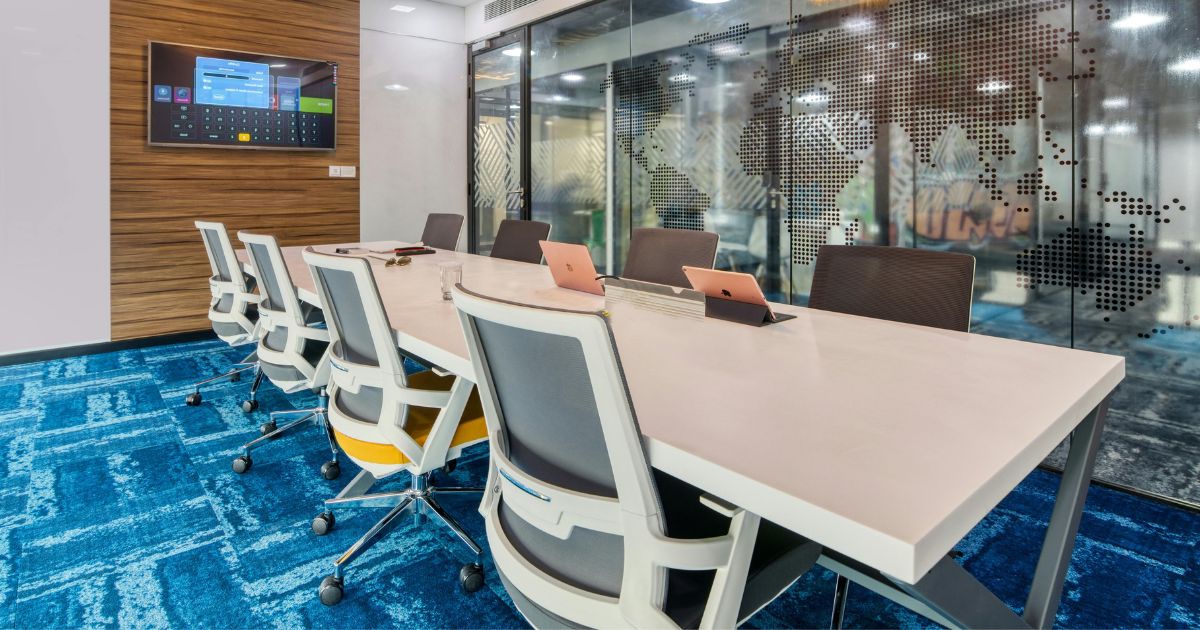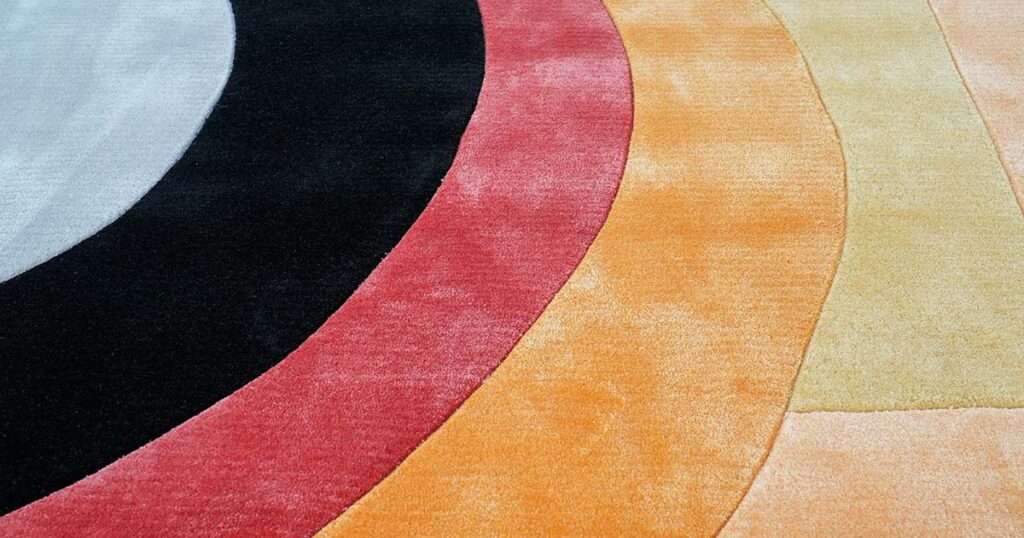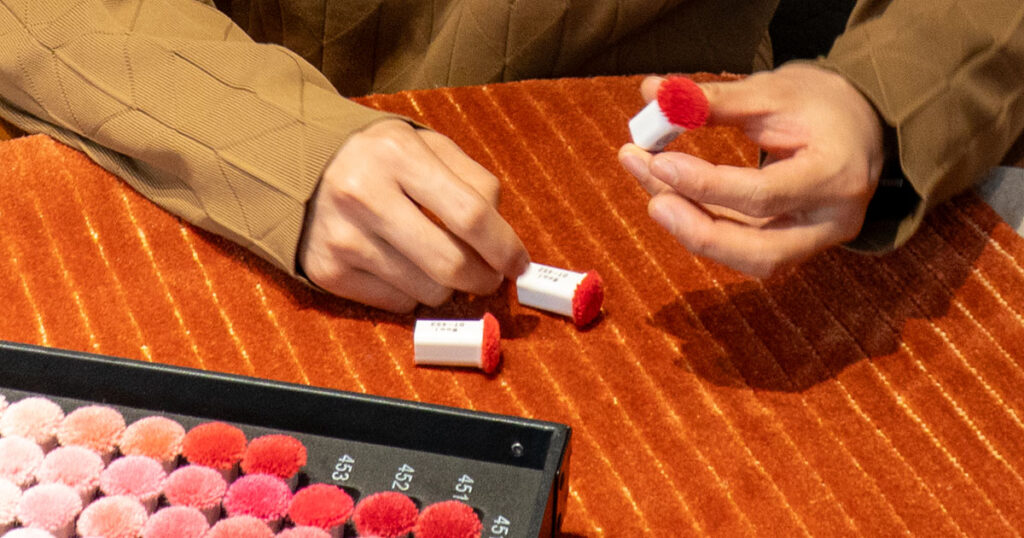Blue rugs offer a versatile design element that can transform any room.
With their calming presence and range of shades, they work beautifully in both traditional and contemporary spaces.
This guide will help you understand the aesthetic potential of blue rugs and provide practical design tips for incorporating them into your home.
Blue Rug Shades and Their Impact
The shade of blue you choose significantly affects the mood and style of your space. Each blue tone creates a distinct atmosphere:
Light Blues: Airy and Expansive
Sky blue and powder blue rugs create an open, airy feeling in a room. These gentle hues evoke clear skies and bring a sense of freshness and tranquility. Light blue rugs work particularly well in smaller spaces where you want to create an illusion of more room.
Medium Blues: Vibrant and Creative
Teal and turquoise bring energy while maintaining blue’s inherent calmness. These vivid mid-tones add a playful, creative element to your decor – perfect for spaces where you want to inspire conversation or creativity.
Dark Blues: Sophisticated and Grounding
Navy, indigo, and royal blue convey depth, stability, and sophistication. A dark blue rug can anchor a room, creating a sense of luxury and intimacy. These deeper tones work beautifully in formal spaces or areas where you want to create a cozy atmosphere.
Design Harmony
Successful interior design depends on thoughtful coordination between different elements.
Here’s how to ensure your blue rug works harmoniously with the rest of your space:
Walls and Color Schemes
Your wall color creates the backdrop for your blue rug. Consider these combinations:
Neutral Walls: White, cream, light gray, or beige walls create a clean canvas that allows a blue rug to become a focal point or a calming anchor.
Blue Walls: Contrary to what you might think, blue walls can work beautifully with blue rugs. The key is varying the intensity – pair light blue walls with a navy rug or deep blue walls with a lighter rug.
Complementary Colors: For a bold look, consider walls in colors opposite blue on the color wheel – soft oranges, terracottas, or warm yellows create striking balance with blue rugs.
Analogous Colors: Green and purple tones neighboring blue on the color wheel create a harmonious, flowing effect when paired with blue rugs.
Furniture and Upholstery
Your furniture interacts closely with your rug, both visually and physically:
Neutral Furniture: Sofas and chairs in white, cream, gray, or beige let a blue rug stand out while maintaining a calm palette.
Warm-Toned Furniture: A camel leather sofa or mustard accent chairs pop beautifully against a navy rug, creating elegant contrast.
Wood Tones: Light woods (oak, maple, pine) contrast nicely with deeper blues, while darker woods (walnut, cherry) complement lighter blue rugs.
Flooring Considerations
The surrounding flooring frames how your blue rug appears:
Hardwood Floors: Blue rugs complement wood tones exceptionally well. Light woods with navy rugs create a striking contrast, while gray-toned or weathered wood pairs beautifully with any blue shade.
Tile or Stone: Blue rugs add much-needed warmth and softness to hard surfaces like tile, marble, or concrete floors.
Blue Rugs in Different Interior Themes
Certain design styles naturally embrace blue rugs. Consider these popular aesthetics:
Coastal and Nautical
Blue is the signature color of seaside-inspired decor. Navy and white striped rugs instantly evoke a classic nautical feel, while aqua or seafoam rugs mirror ocean tones for a relaxed beach house vibe.
Scandinavian Style
In Scandinavian interiors, muted blues (pale blue, gray-blue, washed denim tones) add subtle color to otherwise neutral palettes. A flat-woven blue rug with simple geometric patterns fits perfectly with this clean, minimalist aesthetic.
Bohemian Eclectic
Blue frequently appears in traditional rug patterns from around the world. Indigo-dyed textiles, Turkish kilims with sky blue geometrics, or vintage overdyed rugs in teal all contribute to the global, collected feel of bohemian spaces.
Modern and Contemporary
Bold, saturated blues work well in modern interiors. Look for geometric patterns, abstract designs, or solid blue rugs with interesting textures to complement sleek, contemporary furniture.
Choosing the Right Blue Rug Type
The type of blue rug you select should match both your aesthetic preferences and practical needs:
Area Rugs: Making a Statement
Large blue area rugs define living spaces and set the tone for a room’s design scheme. A room-size navy area rug can make a spacious living room feel more intimate, while a patterned blue area rug can serve as art underfoot.
Runners: Guiding the Eye
Blue runners add color to hallways and corridors, leading the eye through your home. Persian-style blue runners bring elegance to transitional spaces, while striped blue runners add nautical charm to staircases.
Vintage and Traditional: Timeless Appeal
Blue Persian and Oriental rugs often feature navy or indigo in their intricate patterns. These pieces bring history and craftsmanship to any space, working beautifully in both classic and eclectic interiors.
Modern and Contemporary: Bold Impact
Blue contemporary rugs with abstract patterns, geometric designs, or innovative textures add visual interest to minimalist spaces. These rugs pair exceptionally well with sleek, simple furniture.
Textural Variations: Adding Dimension
The texture of your blue rug contributes significantly to its overall effect:
- Plush blue shag rugs create cozy comfort in bedrooms or casual living spaces
- Flatweave blue kilims or dhurries offer graphic patterns perfect for casual or bohemian settings
- Silky viscose blue rugs add a touch of luxury with their subtle sheen
Creating Balance with Blue Rugs
While blue rugs offer many benefits, achieving balance is key to successful design:
Warm + Cool Balance
Blue’s inherent coolness works best when balanced with warm elements. Add warm metals (brass, copper), natural wood tones, or textiles in amber or terracotta to create a harmonious temperature balance.
Pattern Considerations
If your furniture features busy patterns, choose a solid or subtly patterned blue rug. Conversely, if your furniture is mostly solid colors, a patterned blue rug can become a focal point.
Scale and Proportion
Ensure your blue rug is appropriately sized for your furniture arrangement. In living areas, the rug should be large enough for at least the front legs of all seating to rest on it. In dining rooms, all chair legs should remain on the rug even when pulled out.
Lighting Effects
Light significantly impacts how blue appears:
- Natural light enhances the crispness of blues
- Warm artificial lighting may mute blue tones slightly
- Cool white lighting makes blues appear more vivid
Expert Design Tips for Blue Rugs
Take your blue rug styling to the next level with these professional insights:
- Use a blue rug to define zones in open-plan spaces – a defined seating area within a larger room, for example.
- Echo your blue rug color elsewhere in the room – in artwork, pillows, or small accessories – to create cohesion.
- For a monochromatic blue scheme, vary textures significantly to maintain visual interest.
- Consider the room’s function when selecting blue shades: serene light blues for bedrooms, energetic teals for creative spaces, sophisticated navy for formal areas.
- In smaller spaces, lighter blues create airiness, while deeper blues can make a dramatic statement in larger rooms.
Looking for a Blue Rug?
A blue rug offers endless possibilities for elevating your interior design.
From the calming influence of light blues to the sophisticated depth of navy, there’s a perfect blue rug for every space and style.
Consider which shade speaks to you, how it will interact with your existing elements, and what atmosphere you want to create.
Then make your selection with confidence, knowing you’re adding one of interior design’s most versatile and beloved colors to your home.




